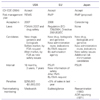Risk management and principal features of REMS
Article information
Abstract
A safe drug is defined as one for which the benefit of the medication is greater than the expected risk, taking all factors into account. To enhance the safety of drugs, the risk of the drugs should be minimized. These risk management (RM) actions are assessment, confrontation, intervention, communication of risk, and evaluation of each process, in that order. To maximize the effect of RM, it should take place as early as possible in the drug life cycle, such as from the drug development period before marketing, and also after marketing. In areas of advanced drug development and a large drug market share, these activities have been legislated as Risk Evaluation and Mitigation Strategies (REMS, 2007) in the United States and the Risk Management Plan (2006) in the EU. REMS is briefly summarized in this paper. In Korea, these policies were accepted and carried out beginning in 2011 as the first stage of legal support and modification of drug safety plans. Also, proactively, the Korea Institute of Drug Safety was launched to manage information about drug safety and develop a scientific method for enhancing RM. RM should be approached in a global scope in order to foster many experts in diverse fields and to keep openness and transparency for close and effective collaboration, which is essential for successful RM and health outcomes.


